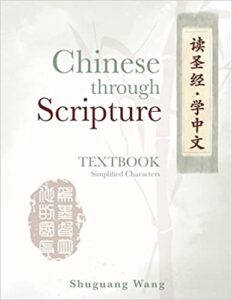Those of you studying Chinese in the early 1990s (like me) probably remember that there were only a handful of textbook options. There was Elementary Chinese Reader (the yellow book) and Practical Chinese Reader (the green book). Some schools used the green book; some the yellow book, and we students were left defending the ones we used much as students would defend their sports teams.
For Christians studying Chinese at that time, materials to learn the language of our faith were even more scarce. Obviously, such books were not being published in China. My teammates and I used photocopied materials that had been developed years earlier in Taiwan called The Good News Reader. Each lesson was a short paragraph made up of simple declarative sentences that we memorized and recited. Shangdi shi shei? Shangdi shi zhenshen. Shangdi ai shishangde ren. “Who is Shangdi? Shangdi is the true God. Shangdi loves all people.” (上帝是谁? 上帝是真神. 上帝爱世上的人.) They had been developed primarily as a tool to teach literacy, not foreign language learning, hence the simplicity.
By the mid-1990s, the material had been expanded and put together in an actual book, also called Good News Reader. My fellow students and I dubbed it “the lips book.” It is still available from AFC for a very modest price, and if you click on the link you will understand our nickname for it.
Last month I had the opportunity to meet Shuguang Wang, the author of a new textbook called Chinese through Scripture. I looked at the book and my first thought was, “I sure could have used this in 1990!”
Let’s just say we’ve come a long way from both versions of The Good News Reader.
Instructor Wang teaches Chinese at Wheaton College and has spent the last few years working on this textbook. I was excited to meet her and learn more about this fantastic resource. She agreed to an email interview to answer three questions about her book.
3 Questions
1. Can you briefly describe what’s in the book and how it’s organized?
Chinese through Scripture integrates the Bible into the teaching and learning of Chinese by introducing basic Christian terms, statements about God, Jesus, worship, and prayer, as well as major Christian themes, all in Chinese. Incorporating vocabulary related to biblical topics empowers learners to engage in conversations about the gospel and Christianity in Chinese.
All of the reading passages and exercises are centered around Scripture from the Bible, allowing learners to practice their reading, comprehension, and vocabulary acquisition skills. There are a total of six units, including “God’s Word,” “The One True God,” “Scripture Alone,” “God’s Saving Grace,” “Justification by Faith,” and “God’s Glory.” The preparatory unit lays the foundation for subsequent content by covering topics such as the classification of books in the Old and New Testaments, core vocabulary for Bible study, a guide to Chinese Bible translations, and an overview of the Bible. Additionally, each unit includes related verses that align with the lesson texts as reference, as well as questions and conversation starters for sharing the Bible and discussing Christian faith.
This textbook is organized systematically and progressively, utilizing the Chinese Union Version translation of the Bible. It takes learners from basic vocabulary and sentence structures to more advanced concepts. Texts, including Bible verses, prayers and stories chosen for the lessons, are familiar to learners with basic background knowledge of the Bible, including the Lord’s Prayer, the Beatitudes, the birth of Jesus, and other familiar passages. There are also numerous supplemental materials, such as examples of conversion prayers and lists of Biblical study terms, and explanations of key characters.
I have also written a workbook that complements the lessons and provides extensive language practice in reading and writing. The workbook incorporates cultural, social, and historical contexts, presenting biblical concepts and content from a Christian perspective. It covers topics related to traditional Chinese thought and Chinese folk religion, equipping learners with practical tools for cultural insights and Christian discourse.
2. How did this book come about?
As a teacher of Chinese, I was inspired to integrate the study of the Chinese language with the wisdom and teachings found in biblical texts. I recognize the inherent value of meaningful content, such as Scripture, in language learning, so I set out to create a resource that would bridge or merge these two areas.
By incorporating Scripture into the language learning process, this book offers a unique opportunity for learners to combine language acquisition with personal growth and spiritual exploration.
There were others involved in the development of this book. I relied heavily on the collaboration of my students, as well as various language experts, biblical scholars, and individuals possessing profound understanding of Chinese culture and religious traditions.
3. Who is it written for? Who will most benefit from it?
This textbook is designed for those who wish to expand their understanding and gain new insights into the reception and translation of the Bible by reading it in another language, as well as for those who desire to learn and use Chinese for ministry and Christian outreach.
I see it as being especially beneficial for:
- Language learners with a passion for spirituality who are seeking to integrate their language learning journey with spiritual growth and exploration will find this book particularly valuable.
- Students of Chinese language and culture who want to gain a deeper understanding of Chinese culture, philosophy, and religious traditions will find this book enriching. It provides insights into the intersection of language, culture, and spirituality, allowing learners to appreciate the depth and richness of the Chinese language within a spiritual context.
- Individuals involved in ministry work or outreach activities in Chinese-speaking communities will find this book beneficial for developing their language skills while also gaining a deeper understanding of biblical teachings and their relevance within the Chinese cultural context.
- Language teachers and educators who are looking for innovative and meaningful resources to facilitate language learning will find Chinese through Scripture a valuable addition to their curriculum. It offers a unique approach that combines language acquisition with spiritual exploration, creating a more holistic and engaging learning experience for their students.
I’ve been out of China for almost ten years now and have not put in much time or effort to maintain my Chinese, much less improve it. I’m hoping this book will change that!
The textbook is available from Amazon in both simplified and traditional Chinese characters.
The workbook is also available on Amazon in both simplified and traditional Chinese characters.
Our thanks to Shuguang Wang for providing a copy of Chinese Through Scripture for this interview.

Joann Pittman
Joann Pittman is Vice President of Partnership and China Engagement and editor of ZGBriefs. Prior to joining ChinaSource, Joann spent 28 years working in China, as an English teacher, language student, program director, and cross-cultural trainer for organizations and businesses engaged in China. She has also taught Chinese at the University …View Full Bio
Are you enjoying a cup of good coffee or fragrant tea while reading the latest ChinaSource post? Consider donating the cost of that “cuppa” to support our content so we can continue to serve you with the latest on Christianity in China.
